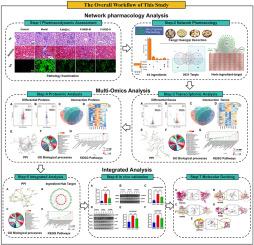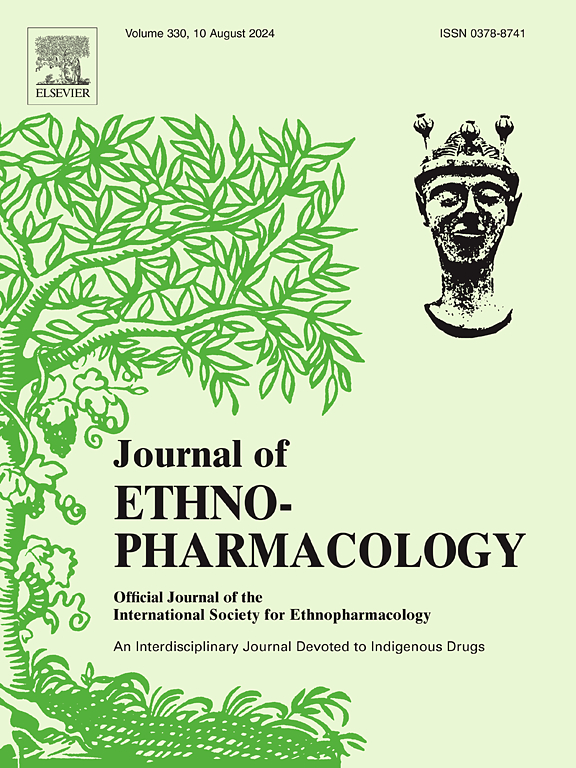Integrative multi-omics and network pharmacology reveal the mechanisms of Fangji Huangqi Decoction in treating IgA nephropathy
IF 4.8
2区 医学
Q1 CHEMISTRY, MEDICINAL
引用次数: 0
Abstract
Ethnopharmacological relevance
Fangji Huangqi Decoction (FJHQD), a classical Chinese herbal formulation, has demonstrated significant clinical efficacy in the treatment of IgA nephropathy (IgAN), although its mechanisms remain poorly understood.
Aim of the study
This study aims to investigate the renal protective mechanisms of FJHQD using an integrated approach that combines transcriptomics, proteomics, and network pharmacology.
Methods
Renal glomerular structure changes were assessed via hematoxylin and eosin (H&E) and Masson staining. IgA expression in the glomeruli was quantified using immunofluorescence. Furthermore, the potential mechanisms underlying the effects of FJHQD were explored through a combined strategy of network pharmacology, transcriptomics, and proteomics. The expression of signaling pathway-related proteins was detected using Western blot.
Results
FJHQD inhibited mesangial cell proliferation and renal interstitial fibrosis, and significantly reduced excessive IgA deposition in the glomerular mesangium. Network pharmacology identified 113 important active components and 8 common active components in FJHQD, with quercetin, isorhamnetin, jaranol, and kaempferol having the highest number of target interactions. Integration of network pharmacology with multi-omics approaches revealed that 44 active components regulated numerous immune and inflammatory signaling pathways through 17 hub targets. These pathways include the Calcium signaling pathway, cAMP signaling pathway, Ras signaling pathway, MAPK signaling pathway, and PI3K-AKT signaling pathway. Subsequent in vivo experiments demonstrated that FJHQD effectively regulates the identified pathways in IgAN mice. Ultimately, molecular docking results further validated the reliability of the network pharmacology combined with multi-omics analyses.
Conclusion
The findings suggest that FJHQD exerts a renal protective effect, potentially through modulation of the Calcium signaling pathway, cAMP signaling pathway, Ras signaling pathway, MAPK signaling pathway, and PI3K-AKT signaling pathway. These insights offer valuable support for the clinical use of FJHQD and open new avenues for exploring the active compounds and molecular mechanisms of Traditional Chinese Medicines (TCMs).

多组学与网络药理学整合揭示防己黄芪汤治疗IgA肾病的机制
民族药理学意义方基黄芪煎剂(FJHQD)是一种经典的中药配方,在治疗IgA肾病(IgAN)方面具有显著的临床疗效,但其作用机制仍不甚明了。方法通过苏木精和伊红(H&E)以及马森染色评估肾小球结构的变化。使用免疫荧光对肾小球中的 IgA 表达进行量化。此外,还通过网络药理学、转录组学和蛋白质组学的综合策略,探索了FJHQD作用的潜在机制。结果FJHQD抑制了系膜细胞增殖和肾间质纤维化,并显著减少了肾小球系膜中过多的IgA沉积。网络药理学发现了 FJHQD 中的 113 种重要活性成分和 8 种常见活性成分,其中槲皮素、异鼠李素、山奈醇和山奈酚具有最多的靶向相互作用。将网络药理学与多组学方法相结合后发现,44 种活性成分通过 17 个中心靶点调控了许多免疫和炎症信号通路。这些通路包括钙信号通路、cAMP 信号通路、Ras 信号通路、MAPK 信号通路和 PI3K-AKT 信号通路。随后的体内实验证明,FJHQD 能有效调节 IgAN 小鼠体内已确定的通路。结论研究结果表明,FJHQD 可通过调节钙信号通路、cAMP 信号通路、Ras 信号通路、MAPK 信号通路和 PI3K-AKT 信号通路发挥肾脏保护作用。这些见解为FJHQD的临床应用提供了宝贵的支持,并为探索中药的活性化合物和分子机制开辟了新的途径。
本文章由计算机程序翻译,如有差异,请以英文原文为准。
求助全文
约1分钟内获得全文
求助全文
来源期刊

Journal of ethnopharmacology
医学-全科医学与补充医学
CiteScore
10.30
自引率
5.60%
发文量
967
审稿时长
77 days
期刊介绍:
The Journal of Ethnopharmacology is dedicated to the exchange of information and understandings about people''s use of plants, fungi, animals, microorganisms and minerals and their biological and pharmacological effects based on the principles established through international conventions. Early people confronted with illness and disease, discovered a wealth of useful therapeutic agents in the plant and animal kingdoms. The empirical knowledge of these medicinal substances and their toxic potential was passed on by oral tradition and sometimes recorded in herbals and other texts on materia medica. Many valuable drugs of today (e.g., atropine, ephedrine, tubocurarine, digoxin, reserpine) came into use through the study of indigenous remedies. Chemists continue to use plant-derived drugs (e.g., morphine, taxol, physostigmine, quinidine, emetine) as prototypes in their attempts to develop more effective and less toxic medicinals.
 求助内容:
求助内容: 应助结果提醒方式:
应助结果提醒方式:


